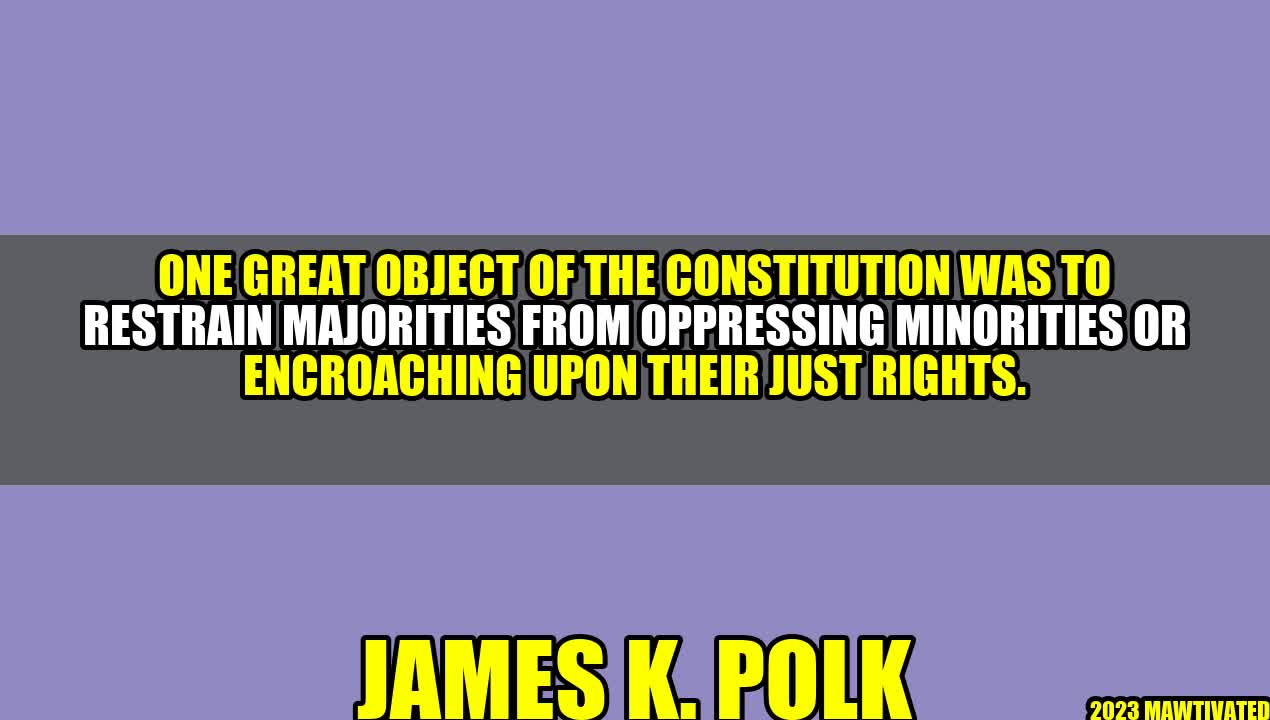Restraint of Majorities on Minorities: The Great Object of the Constitution

An Inspiring Story
On a sunny day in July, Joaquin Oliver walked into his high school in Parkland, Florida, excited to meet his friends. But he never came out alive. A school shooting killed 17 people, including Joaquin, who was only 17.
Joaquin was an artist and activist. He used his art to raise awareness about gun violence and campaign for gun control. Sadly, his voice was silenced forever, but his legacy lives on. His parents founded the group “Change the Ref” to honor his memory and carry on his mission.
Why am I telling you this story? Because it illustrates the importance of protecting minorities from the tyranny of the majority. Joaquin and his fellow students were a minority who advocated for their rights, but their voices were drowned out by the pro-gun lobby and their political supporters.
James K. Polk Story or Background
James K. Polk was the 11th president of the United States, serving from 1845 to 1849. He was a strong believer in the manifest destiny of America, which meant that the country had a divine mission to expand its borders and spread its influence throughout the continent.
However, Polk also understood the importance of balancing power and protecting the rights of minorities. He opposed the expansion of slavery in the western territories and supported the annexation of Texas as a free state. He also helped negotiate the Treaty of Guadalupe Hidalgo, which ended the Mexican-American War and extended the borders of the United States.
The Great Object of the Constitution
The Constitution of the United States was drafted in 1787 to establish a strong federal government and protect the basic liberties of all citizens. One of its key principles was the separation of powers, which divided the government into three branches and prevented any one of them from becoming too powerful.
Another important principle was the protection of minority rights. The framers recognized that majorities could be just as tyrannical as monarchs or dictators if they were not checked by the law and the constitution. They therefore included provisions such as the Bill of Rights, which guaranteed freedom of speech, religion, and the press, as well as the right to bear arms, due process, and equal protection under the law.
As James Madison, one of the architects of the Constitution, wrote in Federalist No. 10, “The influence of factious leaders may kindle a flame within their particular states, but will be unable to spread a general conflagration through the other states: A religious sect may degenerate into a political faction in a part of the Confederacy; but the variety of sects dispersed over the entire face of it must secure the national councils against any danger from that source.”
Examples
- The Civil Rights Movement of the 1950s and 1960s, which fought for racial equality and against segregation, was a minority-led movement that challenged the status quo and made significant gains through nonviolent protest, legislative action, and court rulings.
- The LGBTQ+ community has also faced discrimination and marginalization throughout history, but in recent decades has made substantial progress toward legal recognition, social acceptance, and equal rights under the law.
- The #MeToo movement, which began in 2017 as a hashtag on social media, quickly spread around the world as a grassroots campaign against sexual harassment, assault, and abuse. It has led to numerous high-profile cases of accountability and prompted changes in workplace culture, laws, and policies.
- The Constitution was designed to prevent the tyranny of the majority and protect the rights of minorities.
- Throughout history, minority-led movements have challenged injustice and made significant progress toward greater equality and justice for all.
- We must continue to uphold the principles of the Constitution and support minority rights, even in the face of opposition and adversity.
Practical Tips
Here are some practical tips for advocating for minority rights:
- Get informed: Read books, articles, and online resources about the history, experiences, and struggles of different minority groups.
- Get involved: Volunteer your time, skills, and resources to organizations that support minority rights, such as the ACLU, NAACP, or Human Rights Campaign.
- Speak up: Use your voice, whether it’s through social media, letters to the editor, or conversations with friends and family, to raise awareness about important issues and advocate for change.
- Listen and learn: Be open to different perspectives and experiences, and be willing to change your own opinions and behaviors as you learn more.
Hashtags
#minorityrights #constitution #socialjustice #inclusion #equality #activism #solidarity #humanrights #changetheref #blacklivesmatters #lgbtqrights #metoo
SEO Keywords
Restraint of majorities, minorities, Constitution, James K. Polk, protection, Bill of Rights, Civil Rights Movement, LGBTQ+, #MeToo, practical tips, minority rights
Article Category
Human Rights, Politics, Social Justice

Curated by Team Akash.Mittal.Blog
Share on Twitter
Share on LinkedIn